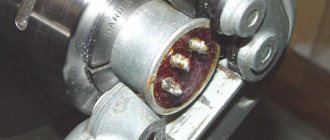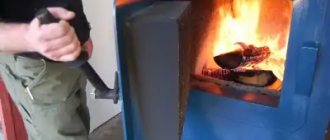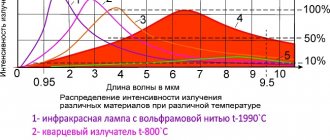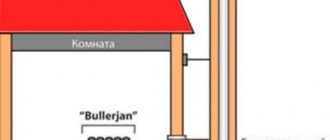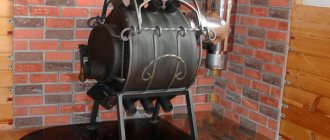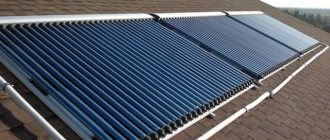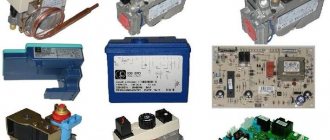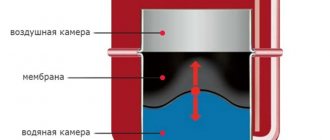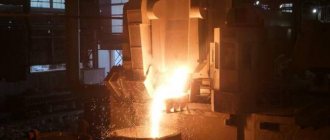General operating principle
At its core, a heat gun is a heat generator for heating rooms. In it, the air flow is heated by the combustion of liquid fuel. It consists of a cylinder with a built-in fan, a pump, a nozzle and a burner. At the very bottom is the fuel tank. The operating principle of a diesel heat gun is simple:
- From the tank, using a pump, fuel enters the nozzle;
- a flammable mixture begins to spread from the nozzle under pressure;
- fuel ignites in the chamber;
- the fan pumps air through the cylinder;
- at the exit we get a stream of highly heated air.
There are 2 types of diesel fuel heat gun:
- Direct heating heat generator.
- Indirect heating heat generator.
Liquid fuel heat guns: types, device
Diesel fuel can be bought, perhaps, everywhere. This explains the high interest in heating units of this kind. But it must be remembered that when burning there is always a smell and fumes. And the cost of heating will be higher when compared, for example, with similar units running on liquefied gas. Therefore, in most cases, a diesel heat gun is purchased as a temporary option - for heating a building under construction, a garage. Such units are convenient for heating warehouses and industrial premises. With good ventilation, direct heating guns can be used. They have an efficiency close to 100%, but combustion products remain in the room. Therefore, well-functioning ventilation is necessary so that the concentration of harmful substances does not exceed permissible limits.
Scope of application of a diesel heat gun
For heating residential buildings, diesel guns are used very rarely. If they are used, then only models with exhaust gas removal. They are also called indirect heating. They have a lower efficiency (80-85%), but combustion products are discharged outside the room. To do this, a chimney pipe is connected to the outlet pipe of the combustion chamber, which is led outside.
Direct heat - high efficiency
The direct heating diesel heating gun has a very simple design. There are two key devices - a fan and a burner. They are built into a metal case. The body most often has the shape of a cylinder and looks very much like a cannon.
Direct heating diesel heat gun device
Fuel is supplied to the nozzle, where it is sprayed and mixed with air. The resulting mixture is set on fire. In well-designed/calculated designs, the flame does not escape beyond the combustion chamber. Only heated air comes out. To increase heating efficiency, there is a fan behind the nozzle that drives air along the combustion chamber.
As can be seen from the design, combustion products enter the room. Therefore, it is very important to use high-quality fuel. One option is kerosene. It has a less unpleasant odor and emits less soot. However, the smell, soot, oxygen burning - all this is present, even if you burn with kerosene.
Indirect heating - with removal of combustion products
A diesel gun with an exhaust outlet differs only in that the combustion chamber is sealed relative to the room. Combustion products are discharged through a pipe in the upper part. A chimney is connected to this pipe, which must be led outside.
How does a diesel fuel heat gun with gas removal (indirect heating) work?
The air driven by the fan flows around the combustion chamber body and heats up. This heats the air in the room. It is clear that this is not nearly as effective as the previous design, but it is much safer. Although ventilation is still needed, since oxygen is still taken from the air. But the exhaust does not remain in the room.
Direct heating heat generator
A direct heating diesel heat gun is not equipped with a chimney and has the simplest design. Therefore, direct-flow heaters are inexpensive, compact, easy to use and reliable. Ignition of the fuel occurs using a spark plug, in some models - from an electric spark gap. The heated stream of air, along with the exhaust gases, enters the building that needs to be warmed up.
The use of such a heater is only possible in non-residential buildings with a good ventilation system or on construction sites (open).
Below is shown the design of a diesel installation using the direct heating method.
Indirect heating heat generator
A diesel heat gun of indirect heating is used in all cases as direct flow. But due to the fact that gases are vented outside, the range of its application expands significantly:
- in construction;
- agriculture;
- Ministry of Emergency Situations;
- in production workshops;
- for drying plaster (putty) during the cold season;
- heating concrete;
- drying facades during facing work;
- for warming trenches;
- heating greenhouses, livestock farms;
- heating residential premises and other things.
The design of diesel heat guns with exhaust gases contains a closed chamber in which fuel burns and a chimney. Fuel is supplied under pressure to the nozzle, in the chamber it is sprayed in the form of an aerosol and ignites. Air is pumped inside the unit by a fan. To maintain the combustion process, part of the air enters the chamber through holes located at the rear. The rest of the flow moves between the heater casing and the combustion chamber, where it is heated. Smoke exits the chamber through the chimney and is discharged outside, bypassing the room.
The use of such diesel heat guns is permitted for heating garages, rooms with people in them, and pavilions. But during the operation of the heater, oxygen burns out, so ventilation must be provided to compensate for its loss.
Multi-fuel heat generators
A liquid fuel heat gun can also be multi-fuel. This means that the unit is capable of operating on waste oil, gasoline, diesel fuel, and kerosene. Often this type of heater is used in places with a sufficient amount of petroleum products and their waste. These could be: fuel warehouses, car parks or car services. At the same time, the problem of recycling waste fuel and lubricants is solved and heating is free.
The figure below shows the operating diagram of a multi-fuel generator.
Model overview
A review of the prices of individual models will help you decide which heat gun is better, gas or diesel.
| Image | Models | price, rub. |
| Ballu BHDP-10 | 13900 | |
| Hyundai H-HD2-20-UI586 | 16600 | |
| Master B 35 CED | 18100 | |
| RESANTA TDP-20000, 20kW red | 13500 | |
| QUATTRO ELEMENTI QE- 22D 243-905 | 14300 | |
| Kerona P-3000E-T | 24200 |
Such quality as mobility allows you to move this equipment to different production or construction sites.
Similar heating equipment is produced by the following companies:
- Master is one of the popular brands. The company has been working in this field for more than 40 years. At the same time, not only diesel models are offered, but also gas and electric ones. The products of this manufacturer have proven themselves to be reliable, safe and affordable;
- Ballu models are mainly used for large production facilities and warehouses. The equipment is known for functionality, good performance and pleasant design;
- Kerona's arsenal includes models of both economy class and luxury class. All models run on kerosene or diesel fuel.
Diesel infrared guns
The liquid fuel infrared heat gun heats large rooms with high efficiency and at the same time efficiency. It can also be successfully used outdoors. This type of heat generator heats the very objects towards which it is directed. Heating of the air occurs from objects heated by the rays, and the height of the ceilings in the room does not play a significant role. Due to these characteristics, significant fuel savings are achieved.
Using this property, it is convenient to spot heat objects in the open air.
How to choose a heat gun
There are a few important things to consider before choosing a heat gun.
- Unit form. Thermal liquid fuel heaters can have a rectangular or cylindrical shape. Due to the large area of air flow distribution, rectangular ones can be used as the best option during indoor construction work.
For spot heating of objects or areas in a room, a cylindrical gun is more suitable.
- Mobility. Portable units are very convenient to use, they are easy to carry, some models are equipped with trolleys. Stationary units are used for constant heating of areas. When installing them, special installation work is required.
Stationary type gun
- Heating method. The air flow can be heated directly or indirectly. This is important if the heater will be used in rooms with people or animals.
- Types of fuel used. The combustible mixture should be selected based on specific situations and the rationality of its use.
- Noisy. Some heat guns (high power) using diesel fuel are not recommended for use in small rooms due to the noise they make.
- Unit power. This parameter should be taken into account first of all before choosing a diesel heat gun. The quality of heating the room or drying it depends on it. Information about the power of the device can be found in its description.
Most heat guns have a temperature control knob that allows you to adjust the operation of the unit to a set room temperature, after which it turns off. The device does not turn on if the temperature on the display is set lower than in the room. Diesel heaters are also equipped with a protection system against overheating.
Diesel heat gun design
To use this equipment correctly, you need to familiarize yourself with its design diagram.
The unit structure includes the following elements:
- protective housing with supports and handles for easy portability of the unit;
- burner for heating the air flow;
- a combustion tank in which the air temperature rises;
- an engine that runs on diesel fuel;
- compressor for pumping fuel;
- fan to direct air flow;
- fuel container.
The operating principle of the devices is quite simple. It depends on the type of heating - direct or indirect.
A direct fired gun works as follows:
- fuel flows from the tank into a special filter, where heating occurs;
- the compressor directs fuel to the injector;
- combustion occurs from the spark plug;
- the fan draws cold air into the combustion tank, where it is heated;
- a special protective design traps the flame and prevents it from escaping from the tank;
- the heated air flow flows in a given direction.
An indirectly heated unit functions in a similar way, but it has a certain advantage - exhaust gases are removed through a special chimney.
When choosing a unit, you need to pay attention to its performance characteristics:
- maximum power rating in kW, for home use up to 8.0 kW is sufficient, for industrial facilities more powerful equipment is needed - from 20.0 kW and above;
- type of heating - direct or indirect;
- features of diesel fuel - refined or unrefined;
- maximum heating area - in square meters;
- fuel consumption – kg/hour;
- power supply – some models require connection to a 220 V power supply.
Choosing a gun with parameters suitable for specific conditions will allow you to solve the problem with the least amount of time and effort.
Other advantages of using the equipment include:
- quick warm-up immediately after startup and transition to working condition;
- most models operate autonomously, without being connected to the mains;
- popular units have compact dimensions and light weight, which ensures their mobility;
- simple operation - you need to fill in diesel and set the necessary operating parameters;
- The volume of the fuel tank ensures long-term operation;
- the body and other structural elements do not heat above 40 degrees, which complies with fire safety standards.
Diesel heat gun for garage
For harsh climatic conditions, the use of thermal units is relevant .
We have looked at how a diesel heat gun for hire works, now we will find out which unit is best suited for heating premises in which vehicles are stored and minor repair work is carried out. If there are no utilities in the room, then a properly selected heating unit will save the situation - it will heat the surrounding air within a short period of time and maintain an optimal temperature regime.
When choosing equipment, it is necessary to take into account the following room features:
- area in sq. meters;
- presence or absence of insulation;
- the approximate time during which it is necessary to warm up the air.
For heating, different types of units are used, but experts recommend choosing diesel units. Both stationary and mobile models are suitable for this. They differ from a conventional fan heater in terms of performance and power. The efficiency of a diesel-powered gun is almost 100.0%, which allows for significant savings on heating costs.
If we consider popular brands, then it is worth paying attention to the following options:
- Elmos DH 51 is an efficient unit with a tank volume of 44.0 liters, which allows you to maintain optimal room temperature for 10-11 hours.
- Elitech TP 25DN is an installation for heating an area of up to 135 square meters, has compact dimensions, and requires connection to the electrical network.
- Master BV 290E - designed for heating car repair shops and large hangars, it is characterized by a powerful air flow and continuous operation for fifteen hours. The remaining fuel in the tank is monitored using a special built-in indicator.
How is the power of a heat gun calculated?
The thermal power of the device is calculated by the formula: V * T * K = kcal/h, where:
- V – volume of the room (width * length * height), in m3;
- T – difference between outside and indoor temperatures, in degrees Celsius;
- K – thermal dissipation coefficient.
For different types of premises the coefficient values are set:
- from 3.0 to 4.0 - a room in which thermal insulation is not provided, for example, a structure made of wood or sheet metal;
- from 2.0 to 2.9 - a room with poor thermal insulation. A simple building with one brick masonry;
- from 1.0 to 1.9 – a building with an average level of thermal insulation (2 bricks and several windows, standard roof);
- from 0.6 to 0.9 – a building with high quality thermal insulation. Brick structure with double insulation. Double glazed windows. The base under the floor is of sufficient thickness. High quality material was used on the roof for insulation.
An example of calculating the power of a diesel heat gun:
- V = 150 m3;
- T = 29° C (outside temperature -10° C, required indoors +19° C, the difference will be - +29° C);
- K = 2 (building with one brick masonry);
We substitute the data into the formula: 150 * 29 * 2 = 8700 kcal/h, despite the fact that 1 kWh = 860 kcal/h. This means: 8700 / 860 = 10.116 kWh. Thus, we learned that to warm up this building, a liquid fuel heat gun with a minimum power of 10 kWh is required. It is recommended to buy a unit with some power reserve.
In warehouse-type premises, garages, hangars, offices or sales areas, workshops, new buildings, where it is not possible to supply centralized heating in winter, the question of a heating option arises very urgently. Often a heat gun is used for this purpose. It should be noted right away that a diesel heat gun is a device designed for heating large non-residential premises equipped with a high-quality ventilation system. In addition, it is used as a working tool when installing suspended ceilings.
Content:
- The most important characteristics of a diesel heat gun
- Types of heat guns
- What is the difference between a directly heated diesel heat gun and an indirectly heated unit video video
- Diesel heat gun - how to make the right choice video
- Formula for calculating the power of a heat gun
- Main advantages: economical
- safety
- Possibility of long-term operation without refueling
- flaws
- price
The most important characteristics of a diesel heat gun
The most important indicator characterizing the quality of a unit’s operation is productivity. It is indicated in the technical data sheet of the device and shows how many kilowatts the gun can produce when operating under maximum load conditions. Based on the performance, you can make an approximate calculation of the power required to heat the room. If the ceiling height is within 3 m, then for heating 10 sq.m. area will need about 1 kW of power. Of course, the obtained figures cannot be considered accurate, because the rooms differ in the quality of the ventilation system, the presence and size of windows, doors or gates, the frequency of their opening, the material from which the walls are made, the quality of their insulation, the presence of insulated floors, and the temperature outside.
Types of heat guns
The design of a heat gun is quite simple; it includes a heating element and a fan. The heating element is heated by electricity obtained from the combustion of gas or liquid fuel. The powerful air flow generated by the fan very quickly distributes heat throughout the room, while energy consumption is minimal.
Based on performance, all units for heating rooms can be divided into:
-industrial, more powerful, designed for heating buildings with poor thermal insulation or large dimensions;
-household, more economical in fuel consumption, used for heating rooms with a small cubic capacity.
Depending on the energy carriers used, heat guns can be electric, gas, multi-fuel, infrared, with a water heat source, or diesel.
In turn, diesel engines are divided into direct and indirect heating units.
They can be equipped with open or closed combustion chambers.
Equipped with a corrugated pipe to remove combustion products, indirectly heated diesel heat guns can be used in rooms with relatively poor ventilation, but if the combustion chamber is open, then the room must be equipped with high-quality ventilation.
Judging by the name, it is easy to conclude that a diesel gun runs on diesel fuel, however, this is not entirely true: kerosene or filtered waste oil can be used as an energy source. The efficiency of such devices is high and tends to 100%.
What is the difference between a direct heating diesel heat gun and an indirect heating unit?
The main differences between the two types of guns are that during the operation of devices with direct heating, fuel combustion products harmful to humans are distributed throughout the room along with the heated air.
With indirect heating, combustion products are filtered in a special chamber with which the gun is equipped. Typically, units operating on the principle of indirect heating are more powerful.
Starting the gun turns on the pump, supplying fuel to the combustion chamber, and the operation of the fan sets in motion the outgoing heated air. At the same time, one that has already cooled down enters the chamber. To improve the quality of combustion, fuel is sprayed using a nozzle, while crushed particles of diesel fuel are mixed with air.
Diesel heat gun - how to make the right choice
Since a heat gun is capable of creating a powerful flow of heated air, its use will be effective even if it is necessary to heat large rooms with significant heat losses and low thermal insulation. But in order for the operation of a direct or indirect heated diesel heat gun to be sufficiently effective, some points should be taken into account:
- will constant heating of the room be required,
- examine the level of air humidity in the room and the amount of heat loss,
- decide on the question of how economical a source of heat you would like to purchase,
- analyze the conditions in which the unit will be operated, determine whether combustion products will need to be removed, and whether the heat source will be transferred from one area of the room to another.
You will also need to calculate, at least approximately, the required power to obtain optimal heating quality.
The choice in favor of diesel heat guns is usually made if the room has good ventilation.
The average power of diesel units ranges from 10 to 220 kW, the volume of air flow is about 8000 cubic meters. m per hour.
When choosing a diesel heat gun for a garage or warehouse, you should be guided by the following rule:
-The more powerful the unit, the more efficient it is.
If there is an excess of heat, then it will not be difficult to regulate its supply, but if the heat is not enough for heating, then you will have to spend money on purchasing another gun. Spending extra money will seem worthwhile to few people.
The location of the heat source is of no small importance for high-quality heating of the room.
For example, in a large room heated by several guns, it would be more rational to place them diagonally than along the wall.
One should also take into account the fact that warm air always tends upward, i.e. It makes no sense to place the gun on a stand or table and point its working edge towards the top.
The best option for placing the unit is on the floor, in a horizontal position.
Formula for calculating the power of a heat gun
To calculate the power of a thermal unit, you can use the formula
Q = V x T xk,
in this case, Q means the power required for heating, V is the cubic capacity of the room, T is the difference in temperatures inside and outside the room, k is the dissipation coefficient.
To obtain the temperature difference, you will need to subtract the temperature of the environment surrounding the room from the recommended room temperature.
Coefficient k, depending on the thermal insulation characteristics of the structure, can have the following values:
3-4 - for non-insulated wooden and metal buildings,
2 - 2.9 - for brick (1 brick) structures with non-insulated windows,
1 - 1.9 - for brick (two bricks) buildings with a regular roof,
0.6 - 0.9 - for insulated rooms.
When choosing a heat gun of appropriate power, you should take into account its dimensions and weight, because in some cases it will be installed permanently, in others its location will need to be changed.
Main advantages
Although today there are many options for heating non-residential premises, practically none of the heating devices can compare with a heat gun in terms of efficiency. Among its main advantages we should remember:
- relatively small dimensions and light weight, which are of significant importance in modern requirements for various types of heating equipment,
- Convenience and ease of operation, to start the mechanism you only need to press a button,
- the ability to control the temperature in the room, the presence of a rheostat connection system,
- To optimize the operation of the unit, it is necessary to set the desired temperature before starting the gun; shutdown occurs automatically when the desired temperature is reached.
efficiency
Another attractive feature is the economical operation of the device. For example, a diesel heat gun for a garage will consume 1.5 liters of diesel fuel per hour, while the air flow will be 550 cubic meters. m, the power of the device will be 20 kW.
Diesel heat guns, according to the instructions, can instantly warm up the air in a room. To heat a room with a sufficiently large cubic capacity at the calculated power of the gun, it will take only 10-15 minutes to increase the temperature by 10-12 degrees.
safety
A positive point is also the low heating of the body - when the gun is operating, its temperature rises to only 30 - 35 degrees, i.e. accidentally touching the body cannot cause burns.
If the ventilation in the room meets the requirements, then the possibility of discomfort from inhaling burnt-out air or fuel combustion products is completely eliminated.
Possibility of long-term operation without refueling
Large volume of fuel tank, for example, the Elitech diesel heat gun with a fuel consumption of only 1.3 liters per hour has a fuel tank with a volume of 19 liters, which allows it to operate for a long period without refueling. Some models generally provide a tank volume such that the gun can operate without refueling for 24 hours.
flaws
If we talk about the disadvantages, the main and only thing will be strict restrictions regarding operating conditions: the impossibility of use in residential premises and the mandatory presence of high-quality ventilation, an oxygen supply system and a system for reducing the concentration of combustion products in heated premises.
price
On sale today you can find heat guns of different power and operating on different types of fuel, but the most popular are diesel heat guns, the price of which depends on their power and operating principle.
It can range from 11 to 60 thousand rubles and more.
Author: Sergey and Svetlana Khudentsov
10
Advantages of diesel heat generators
There are several positive aspects when using diesel heat guns:
- excellent performance characteristics;
- ease of maintenance;
- power can reach up to 230 kW;
- very low fuel consumption;
- battery life more than 10 hours;
- works well at low temperatures;
- the ability to quickly heat large areas.
Based on the above positive aspects, we can say with confidence that a heat gun is the most effective device for heating residential and industrial premises.
